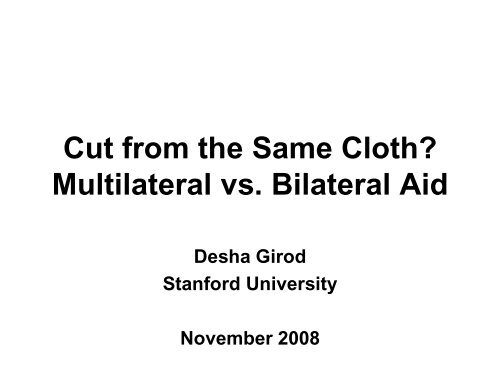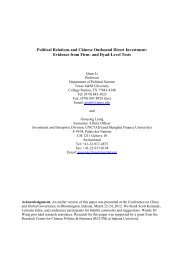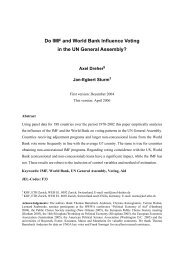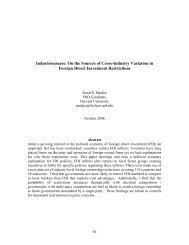Cut from the Same Cloth? Multilateral vs. Bilateral Aid
Cut from the Same Cloth? Multilateral vs. Bilateral Aid
Cut from the Same Cloth? Multilateral vs. Bilateral Aid
Create successful ePaper yourself
Turn your PDF publications into a flip-book with our unique Google optimized e-Paper software.
<strong>Cut</strong> <strong>from</strong> <strong>the</strong> <strong>Same</strong> <strong>Cloth</strong>?<br />
<strong>Multilateral</strong> <strong>vs</strong>. <strong>Bilateral</strong> <strong>Aid</strong><br />
Desha Girod<br />
Stanford University<br />
November 2008
Development is elusive to some<br />
impoverished i states t that t receive aid<br />
For example: DR Congo, Somalia<br />
In o<strong>the</strong>r impoverished states, governments<br />
seem to facilitate development with aid<br />
For example: EU ascension states,<br />
Ghana, Mozambique<br />
Uganda, Guatemala<br />
2
The puzzle and <strong>the</strong> literature<br />
Why do some governments use aid<br />
better than o<strong>the</strong>rs?<br />
<strong>Aid</strong> Donor threat to Reform Growth<br />
withdraw is<br />
credible<br />
Studies have identified several cases<br />
when donors’ threat to withdraw is<br />
credible<br />
All donors: After <strong>the</strong> Cold War (Dunning 2004; Bearce and Tirone 2008)<br />
IMF: When a strategic interest is not at stake (Thacker 1999; Stone 2002)<br />
3
The puzzle and <strong>the</strong> <strong>the</strong>ory<br />
Why do some governments use aid better than<br />
o<strong>the</strong>rs?<br />
<strong>Aid</strong> Donor threat to Reform Growth<br />
withdraw is<br />
credible<br />
<strong>Bilateral</strong> v. <strong>Multilateral</strong> aid<br />
<strong>Multilateral</strong> t l donors are less likely l to coordinate on<br />
any particular strategic interest than bilateral donors<br />
4
Method: Quantitative analysis<br />
- Existing dataset on determinants<br />
of aid and on determinants of<br />
growth<br />
- Previously undisclosed data on<br />
reform <strong>from</strong> <strong>the</strong> World Bank<br />
5
Contribution: <strong>Multilateral</strong> aid works<br />
better than bilateral l aid<br />
New evidence to explain <strong>the</strong> effects<br />
of aid on development:<br />
Positive effects only for multilateral aid, with<br />
conditions that are more likely to be<br />
enforced.<br />
6
Outline<br />
I. Theory<br />
II. Statistical tests<br />
III. Conclusion<br />
7
Reform requires incentives<br />
Donor countries disburse aid with many objectives.<br />
Theory<br />
Donor goal<br />
<strong>Aid</strong> Conditions<br />
Includes strategic<br />
(bilateral)<br />
Unenforceable<br />
Mainly development<br />
(multilateral)<br />
Enforceable<br />
Hypo<strong>the</strong>sis 1a: <strong>Multilateral</strong> donors should disburse greater amounts of<br />
aid to governments that comply py with reform more.<br />
Hypo<strong>the</strong>sis 1b: <strong>Bilateral</strong> donors should not disburse greater amounts of<br />
aid to governments that comply with reform more.<br />
8
Growth requires reform<br />
Theory<br />
Policies that limit <strong>the</strong> executive’s ability to be<br />
predatory are common across reforms over time.<br />
Hypo<strong>the</strong>sis 2a: States receiving higher amounts of multilateral aid<br />
should experience more growth than states receiving lower<br />
amounts of multilateral aid.<br />
Hypo<strong>the</strong>sis 2b: States receiving higher amounts of bilateral aid should<br />
not experience more growth than states receiving lower amounts<br />
of bilateral aid.<br />
Why does multilateral aid work?<br />
Hypo<strong>the</strong>sis 3: Reform should positively affect growth while suppressing<br />
<strong>the</strong> positive effects of multilateral aid on growth.<br />
Why do leaders need enforceable conditions to<br />
implement reform?<br />
Unconditional aid = resource wealth<br />
Pressure to invest in immediate needs and interests<br />
9
Tests of <strong>the</strong> <strong>the</strong>ory<br />
Reform <strong>Aid</strong>?<br />
Hypo<strong>the</strong>sis 1a: <strong>Multilateral</strong> donors should disburse greater amounts of<br />
aid to governments that t comply with reform more.<br />
Hypo<strong>the</strong>sis 1b: <strong>Bilateral</strong> donors should not disburse greater amounts of<br />
aid to governments that comply with reform more.<br />
<strong>Aid</strong> Growth?<br />
Hypo<strong>the</strong>sis 2a: States receiving higher amounts of multilateral aid<br />
should experience more growth than states receiving lower<br />
amounts of multilateral aid.<br />
Hypo<strong>the</strong>sis 2b: States receiving higher amounts of bilateral aid should<br />
not experience more growth than states receiving lower amounts<br />
of bilateral aid.<br />
Reform Growth?<br />
Hypo<strong>the</strong>sis 3: Reform should positively affect growth while suppressing<br />
<strong>the</strong> positive effects of multilateral aid on growth.<br />
10
Hypo<strong>the</strong>ses 1<br />
<strong>Aid</strong> for reform?<br />
Sample: Panel of developing-country years, 1964-1999<br />
1999<br />
Dependent variable(s): <strong>Multilateral</strong> aid, <strong>Bilateral</strong> aid<br />
Independent variable: Reform (lagged)<br />
Model: Tobit<br />
11
Hypo<strong>the</strong>sis 1<br />
<strong>Aid</strong> interests ests of multilateral ut atea and<br />
bilateral donors diverge<br />
AID FLOWS: MULTILATERAL BILATERAL<br />
Reform 0.141** 0.024<br />
(lagged) (0.062) (0.038)<br />
+ controls<br />
12
Hypo<strong>the</strong>sis 1<br />
<strong>Aid</strong> interests ests of multilateral ut atea and<br />
bilateral donors diverge<br />
AID FLOWS: MULTILATERAL BILATERAL<br />
Reform 0.141** 0.024<br />
(lagged) (0.062) (0.038)<br />
Cold War 0.046046 0.103***<br />
(0.028) (0.024)<br />
+ controls<br />
13
Tests of <strong>the</strong> <strong>the</strong>ory<br />
Reform <strong>Aid</strong>? Yes for multilateral<br />
Hypo<strong>the</strong>sis 1a: <strong>Multilateral</strong> donors should disburse greater amounts of<br />
aid to governments that t comply with reform more.<br />
Hypo<strong>the</strong>sis 1b: <strong>Bilateral</strong> donors should not disburse greater amounts<br />
of aid to governments that comply with reform more.<br />
<strong>Aid</strong> Growth?<br />
Hypo<strong>the</strong>sis 2a: States receiving higher amounts of multilateral aid<br />
should experience more growth than states receiving lower<br />
amounts of multilateral aid.<br />
Hypo<strong>the</strong>sis 2b: States receiving higher amounts of bilateral aid should<br />
not experience more growth than states receiving lower amounts<br />
of bilateral aid.<br />
14
Hypo<strong>the</strong>sis 2<br />
Does aid encourage growth?<br />
<strong>Multilateral</strong> <strong>vs</strong>. <strong>Bilateral</strong> aid<br />
Sample: 64 country-four-year year periods, 1966-1997<br />
1997<br />
Dependent variable: Annual growth (4-year average)<br />
Independent variable(s): <strong>Multilateral</strong> aid, <strong>Bilateral</strong> aid<br />
Model: OLS regression<br />
15
Hypo<strong>the</strong>sis 2<br />
<strong>Multilateral</strong> aid facilitates growth<br />
Dependent variable: Annual growth (4-year average)<br />
<strong>Multilateral</strong> aid 0.318**<br />
(0.144)<br />
+ controls<br />
<strong>Bilateral</strong> aid -0.022<br />
(0.113)<br />
+ controls<br />
Total aid 0.051<br />
(0.156)<br />
+ controls<br />
16
Results Hold Across<br />
Alternative Specifications<br />
- Period fixed effects<br />
- Excluding outliers<br />
- Controlling for Sachs Warner (SW) Index<br />
- Controlling for budget balance<br />
- Controlling for SW index and budget<br />
balance<br />
- Controlling for human capital<br />
- Controlling for domestic investment<br />
- Accounting for endogeneity<br />
- Including o<strong>the</strong>r regions<br />
17
Tests of <strong>the</strong> <strong>the</strong>ory<br />
Reform <strong>Aid</strong>? Yes for multilateral<br />
Hypo<strong>the</strong>sis 1a: <strong>Multilateral</strong> donors should disburse greater amounts of<br />
aid to governments that t comply with reform more.<br />
Hypo<strong>the</strong>sis 1b: <strong>Bilateral</strong> donors should not disburse greater amounts<br />
of aid to governments that comply with reform more.<br />
<strong>Aid</strong> Growth? Yes for multilateral<br />
Hypo<strong>the</strong>sis 2a: States receiving higher amounts of multilateral aid<br />
should experience more growth than states receiving lower<br />
amounts of multilateral aid.<br />
Hypo<strong>the</strong>sis 2b: States receiving higher amounts of bilateral aid should<br />
not experience more growth than states receiving lower amounts<br />
of bilateral aid.<br />
Reform Growth?<br />
Hypo<strong>the</strong>sis 3: Reform should positively affect growth while suppressing<br />
<strong>the</strong> positive effects of multilateral aid on growth.<br />
18
Hypo<strong>the</strong>sis 3<br />
Why does multilateral aid work?<br />
Sample: 64 country-four-year periods, 1966-1997<br />
Dependent variable: Annual growth (4-year average)<br />
Independent variable: <strong>Multilateral</strong> aid<br />
Mediator variable: Reform<br />
Model: OLS regression<br />
19
Hypo<strong>the</strong>sis 3<br />
Reform links multilateral aid and growth<br />
Dependent variable: Annual growth (4-year average)<br />
(1) (2)<br />
<strong>Multilateral</strong> aid 0.429** 0.341*<br />
(0.180) (0.178)<br />
Reform 1.805***<br />
(0.628)<br />
+ controls<br />
20
Tests of <strong>the</strong> <strong>the</strong>ory<br />
Reform <strong>Aid</strong>? Yes for multilateral<br />
Hypo<strong>the</strong>sis 1a: <strong>Multilateral</strong> donors should disburse greater amounts of<br />
aid to governments that t comply with reform more.<br />
Hypo<strong>the</strong>sis 1b: <strong>Bilateral</strong> donors should not disburse greater amounts<br />
of aid to governments that comply with reform more.<br />
<strong>Aid</strong> Growth? Yes for multilateral<br />
Hypo<strong>the</strong>sis 2a: States receiving higher amounts of multilateral aid<br />
should experience more growth than states receiving lower<br />
amounts of multilateral aid.<br />
Hypo<strong>the</strong>sis 2b: States receiving higher amounts of bilateral aid should<br />
not experience more growth than states receiving lower amounts<br />
of bilateral aid.<br />
Reform Growth? Suggests yes<br />
Hypo<strong>the</strong>sis 3: Reform should positively affect growth while<br />
suppressing <strong>the</strong> positive effects of multilateral aid on growth.<br />
21
Conclusion: Findings<br />
1. <strong>Multilateral</strong> aid helps. Reform is a<br />
mechanism.<br />
2. <strong>Bilateral</strong> aid doesn’t help<br />
3. Plausible reason for divergence: <strong>Bilateral</strong> aid<br />
is more subject to <strong>the</strong> “aid curse”<br />
22
Conclusion: Implications<br />
1. Enforcement of conditions matters<br />
2. Tension exists between strategic and<br />
development interests of donors<br />
3. Rise in unconditional bilateral aid (War<br />
on Terror, China) could reduce<br />
prospects for growth<br />
4. What can be done? Tie <strong>the</strong> hands of<br />
bilateral donors<br />
23







